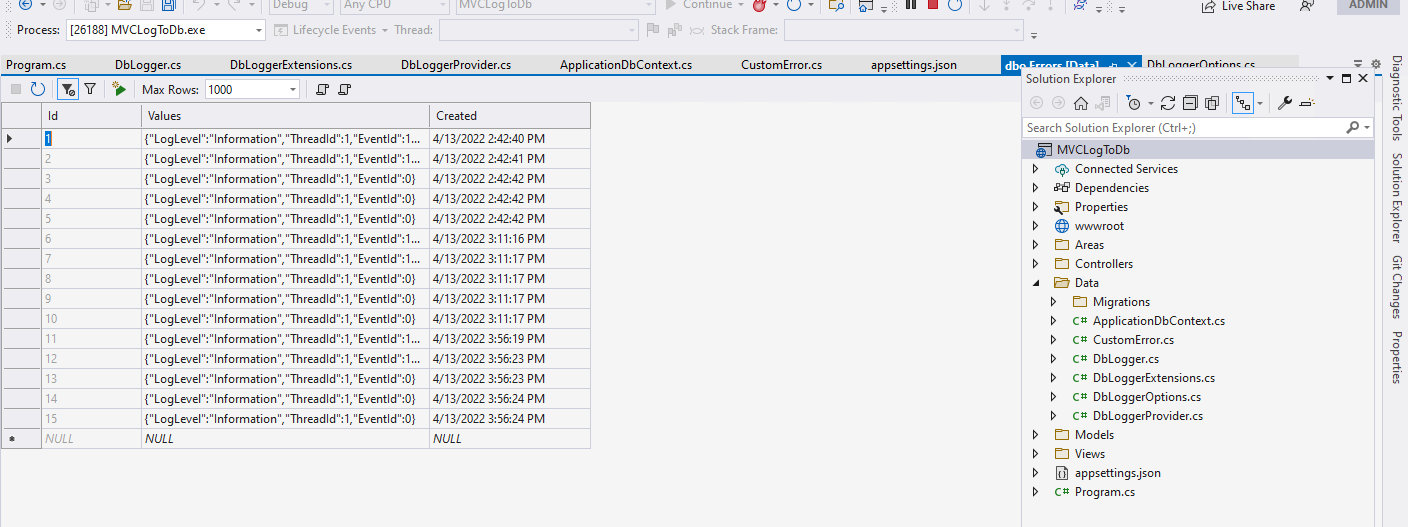Hi @Prathamesh Shende ,
Here is an article about Create a custom database logging provider with ASP.NET Core ILogger, it will use the ADO.Net methods to insert the log into database. I also try to modify the code to use EF core and Dbcontext, but it keeps showing the Cannot consume scoped servicea from singleton service error and stackoverflow issue.
So, I suggest you could refer the article or the following steps and use ADO.Net method to insert the log to the database.
1.Create a new Asp.net core web application and add the following custom error model:
public class CustomError
{
public int Id { get; set; }
public string Values { get; set; }
public DateTime Created { get; set; }
}
public class ApplicationDbContext : IdentityDbContext
{
public DbSet<CustomError> Errors { get; set; }
public ApplicationDbContext(DbContextOptions<ApplicationDbContext> options)
: base(options)
{
}
}
Then, enable migration and generate the database and the Errors table.
2.Add a DbLoggerOptions class to store the logger settings:
// DbLoggerOptions.cs
public class DbLoggerOptions
{
public string ConnectionString { get; init; }
public string[] LogFields { get; init; }
public string LogTable { get; init; }
public DbLoggerOptions()
{
}
}
The appsettings.json file like this:
{
"ConnectionStrings": {
"DefaultConnection": "Server=(localdb)\\mssqllocaldb;Database=aspnet-MVCLogToDb-D3A8C17C-FEB5-4F32-B4A8-3449605330CF;Trusted_Connection=True;MultipleActiveResultSets=true"
},
"Logging": {
"Database": {
"Options": {
"ConnectionString": "Server=(localdb)\\mssqllocaldb;Database=aspnet-MVCLogToDb-D3A8C17C-FEB5-4F32-B4A8-3449605330CF;Trusted_Connection=True;MultipleActiveResultSets=true",
"LogFields": [
"LogLevel",
"ThreadId",
"EventId",
"EventName",
"ExceptionMessage",
"ExceptionStackTrace",
"ExceptionSource"
],
"LogTable": "dbo.Errors"
}
},
"LogLevel": {
"Default": "Information",
"Microsoft.AspNetCore": "Warning",
"RoundTheCode.LoggerDb": "Error"
}
},
"AllowedHosts": "*"
}
3.Creating the custom logging provider
//DbLoggerProvider.cs
ProviderAlias("Database")]
public class DbLoggerProvider : ILoggerProvider
{
public readonly DbLoggerOptions Options;
public DbLoggerProvider(IOptions<DbLoggerOptions> _options)
{
Options = _options.Value; // Stores all the options.
}
/// <summary>
/// Creates a new instance of the db logger.
/// </summary>
/// <param name="categoryName"></param>
/// <returns></returns>
public ILogger CreateLogger(string categoryName)
{
return new DbLogger(this);
}
public void Dispose()
{
}
}
Add the logger instance:
//DbLogger.cs
public class DbLogger : ILogger
{
/// <summary>
/// Instance of <see cref="DbLoggerProvider" />.
/// </summary>
private readonly DbLoggerProvider _dbLoggerProvider;
/// <summary>
/// Creates a new instance of <see cref="FileLogger" />.
/// </summary>
/// <param name="fileLoggerProvider">Instance of <see cref="FileLoggerProvider" />.</param>
public DbLogger([NotNull] DbLoggerProvider dbLoggerProvider)
{
_dbLoggerProvider = dbLoggerProvider;
}
public IDisposable BeginScope<TState>(TState state)
{
return null;
}
/// <summary>
/// Whether to log the entry.
/// </summary>
/// <param name="logLevel"></param>
/// <returns></returns>
public bool IsEnabled(LogLevel logLevel)
{
return logLevel != LogLevel.None;
}
/// <summary>
/// Used to log the entry.
/// </summary>
/// <typeparam name="TState"></typeparam>
/// <param name="logLevel">An instance of <see cref="LogLevel"/>.</param>
/// <param name="eventId">The event's ID. An instance of <see cref="EventId"/>.</param>
/// <param name="state">The event's state.</param>
/// <param name="exception">The event's exception. An instance of <see cref="Exception" /></param>
/// <param name="formatter">A delegate that formats </param>
public void Log<TState>(LogLevel logLevel, EventId eventId, TState state, Exception exception, Func<TState, Exception, string> formatter)
{
if (!IsEnabled(logLevel))
{
// Don't log the entry if it's not enabled.
return;
}
var threadId = Thread.CurrentThread.ManagedThreadId; // Get the current thread ID to use in the log file.
// Store record.
using (var connection = new SqlConnection(_dbLoggerProvider.Options.ConnectionString))
{
connection.Open();
// Add to database.
// LogLevel
// ThreadId
// EventId
// Exception Message (use formatter)
// Exception Stack Trace
// Exception Source
var values = new JObject();
if (_dbLoggerProvider?.Options?.LogFields?.Any() ?? false)
{
foreach (var logField in _dbLoggerProvider.Options.LogFields)
{
switch (logField)
{
case "LogLevel":
if (!string.IsNullOrWhiteSpace(logLevel.ToString()))
{
values["LogLevel"] = logLevel.ToString();
}
break;
case "ThreadId":
values["ThreadId"] = threadId;
break;
case "EventId":
values["EventId"] = eventId.Id;
break;
case "EventName":
if (!string.IsNullOrWhiteSpace(eventId.Name))
{
values["EventName"] = eventId.Name;
}
break;
case "Message":
if (!string.IsNullOrWhiteSpace(formatter(state, exception)))
{
values["Message"] = formatter(state, exception);
}
break;
case "ExceptionMessage":
if (exception != null && !string.IsNullOrWhiteSpace(exception.Message))
{
values["ExceptionMessage"] = exception?.Message;
}
break;
case "ExceptionStackTrace":
if (exception != null && !string.IsNullOrWhiteSpace(exception.StackTrace))
{
values["ExceptionStackTrace"] = exception?.StackTrace;
}
break;
case "ExceptionSource":
if (exception != null && !string.IsNullOrWhiteSpace(exception.Source))
{
values["ExceptionSource"] = exception?.Source;
}
break;
}
}
}
using (var command = new SqlCommand())
{
command.Connection = connection;
command.CommandType = System.Data.CommandType.Text;
command.CommandText = string.Format("INSERT INTO {0} ([Values], [Created]) VALUES (@Values, @Created)", _dbLoggerProvider.Options.LogTable);
command.Parameters.Add(new SqlParameter("@Values", JsonConvert.SerializeObject(values, new JsonSerializerSettings
{
NullValueHandling = NullValueHandling.Ignore,
DefaultValueHandling = DefaultValueHandling.Ignore,
Formatting = Formatting.None
}).ToString()));
command.Parameters.Add(new SqlParameter("@Created", DateTimeOffset.Now));
command.ExecuteNonQuery();
}
connection.Close();
}
}
}
Then, configuration extension method:
//DbLoggerExtensions.cs
public static class DbLoggerExtensions
{
public static ILoggingBuilder AddDbLogger(this ILoggingBuilder builder, Action<DbLoggerOptions> configure)
{
builder.Services.AddSingleton<ILoggerProvider, DbLoggerProvider>();
builder.Services.Configure(configure);
return builder;
}
}
4.Adding the logger provider to the ASP.NET Core application
// Program.cs
var builder = WebApplication.CreateBuilder(args);
...
builder.Logging.AddDbLogger(options =>
{
builder.Configuration.GetSection("Logging").GetSection("Database").GetSection("Options").Bind(options);
});
var app = builder.Build();
...
app.Run();
After running the application, the result like this:

If the answer is the right solution, please click "Accept Answer" and kindly upvote it. If you have extra questions about this answer, please click "Comment".
Note: Please follow the steps in our documentation to enable e-mail notifications if you want to receive the related email notification for this thread.
Best regards,
Dillion



